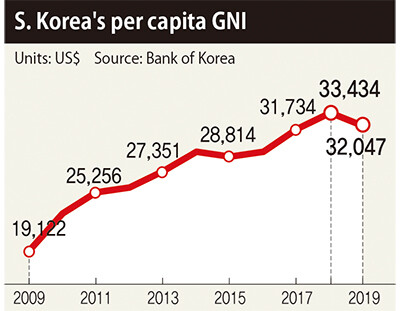hankyoreh
Links to other country sites 다른 나라 사이트 링크
S. Korea’s per capita GNI falls by 4.1% in 2019, biggest decline in 10 years

South Korea’s per capita gross national income (GNI) shrank by 4.1% in US dollar value last year, the biggest decline in 10 years. The 1.3% rate of increase in real gross domestic product (GDP) for the fourth quarter of 2019 was 0.1 percentage point higher than the flash estimate, but the annual growth rate remained unchanged at 2.0%.
According to provisional figures on the fourth quarter and annual national income for 2019 released by the Bank of Korea (BOK) on Mar. 3, per capita GNI stood at US$32,047 last year, down by 4.1% (US$1,387) from US$33,434 the previous year. The decline was the largest since the -10.4% decline observed in 2009 at the time of the global financial crisis. The decline in per capita national income was the first in the four years since 2015 (-1.9%). When calculated in South Korean won, per capita GNI increased by 1.5% from 2018 to 37,356,000 -- but the declining value of the won resulted in lower income when represented in US dollars. South Korea first entered its “era of national income over US$30,000” in 2017, when the total reached US$31,734. BOK explained, “In addition to the factor of the rising [won-to-dollar] exchange rate, national income also declined due to slow exports and investment and declining trade conditions.”
BOK gave a provisional real growth rate estimate of 2.0% for last year, which was the same level as the flash estimate announced in January. The number was the lowest since 2009, when it stood at 0.8%. The fourth quarter real growth rate was calculated at 1.3% compared to the previous quarter, which was 0.1 percentage points higher than the flash estimate of 1.2%. The number reflected higher rates of increase in facility investment (1.8 percentage points), construction investment (0.7), and private consumption (0.2). The private sector accounted for a 0.5-percentage point contribution to annual growth, while the government accounted for 1.5 percentage points.
The nominal growth rate for last year was far lower than the real growth rate at just 1.1%. It was the lowest nominal growth rate in the 21 years since 1998, when it was calculated at -0.9% amid the foreign exchange crisis. This was the result of the GDP deflator (nominal GDP divided by real GDP) -- a measure to show the overall level of prices in the national economy -- falling by 0.9% from the year before amid a steep drop in prices for major export items. It was the first negative year-to-year GDP deflator value since 2006, when it was calculated at -0.2%. The gross savings rate stood at 34.6%, down 1.2 percentage points from the year before to its lowest level since 2012 (34.5%).
“The fourth quarter of last year saw a trend of recovery in private domestic demand, including consumption and investment, but that trend may be difficult to sustain this year due to the situation with the novel coronavirus,” said Park Sung-bin, director of the BOK Economic Statistics Department.
“But exports did show a trend of recovery in January and February this year,” Park added.
By Han Gwang-deok, finance correspondent
Please direct comments or questions to [english@hani.co.kr]

Editorial・opinion
![[Column] When ‘fairness’ means hate and violence [Column] When ‘fairness’ means hate and violence](https://flexible.img.hani.co.kr/flexible/normal/500/300/imgdb/original/2024/0516/7417158465908824.jpg) [Column] When ‘fairness’ means hate and violence
[Column] When ‘fairness’ means hate and violence![[Editorial] Yoon must stop abusing authority to shield himself from investigation [Editorial] Yoon must stop abusing authority to shield himself from investigation](https://flexible.img.hani.co.kr/flexible/normal/500/300/imgdb/original/2024/0516/4417158464854198.jpg) [Editorial] Yoon must stop abusing authority to shield himself from investigation
[Editorial] Yoon must stop abusing authority to shield himself from investigation- [Column] US troop withdrawal from Korea could be the Acheson Line all over
- [Column] How to win back readers who’ve turned to YouTube for news
- [Column] Welcome to the president’s pity party
- [Editorial] Korea must respond firmly to Japan’s attempt to usurp Line
- [Editorial] Transfers of prosecutors investigating Korea’s first lady send chilling message
- [Column] Will Seoul’s ties with Moscow really recover on their own?
- [Column] Samsung’s ‘lost decade’ and Lee Jae-yong’s mismatched chopsticks
- [Correspondent’s column] The real reason the US is worried about Chinese ‘overcapacity’
Most viewed articles
- 1Could Korea’s Naver lose control of Line to Japan?
- 2[Column] Welcome to the president’s pity party
- 3[Column] US troop withdrawal from Korea could be the Acheson Line all over
- 4Naver’s union calls for action from government over possible Japanese buyout of Line
- 5[Editorial] Korea must respond firmly to Japan’s attempt to usurp Line
- 6Korea cedes No. 1 spot in overall shipbuilding competitiveness to China
- 7[Editorial] Yoon must stop abusing authority to shield himself from investigation
- 8[Column] When ‘fairness’ means hate and violence
- 9Korean opposition decries Line affair as price of Yoon’s ‘degrading’ diplomacy toward Japan
- 10Second suspect nabbed for gruesome murder of Korean in Thailand, 1 remains at large